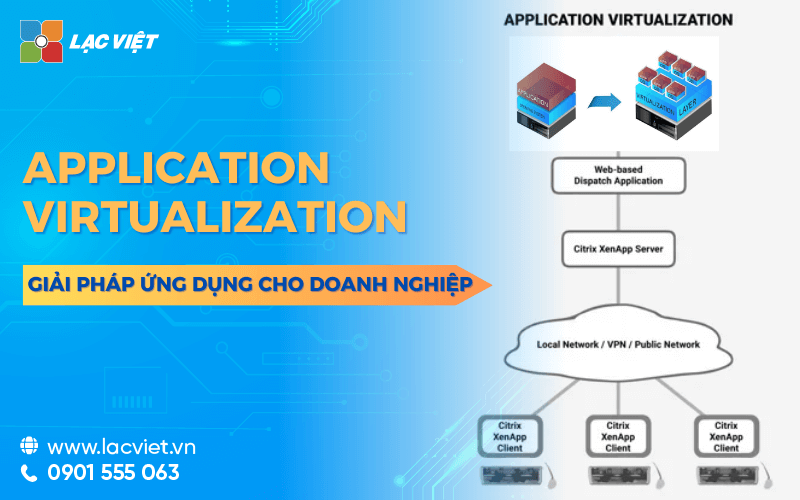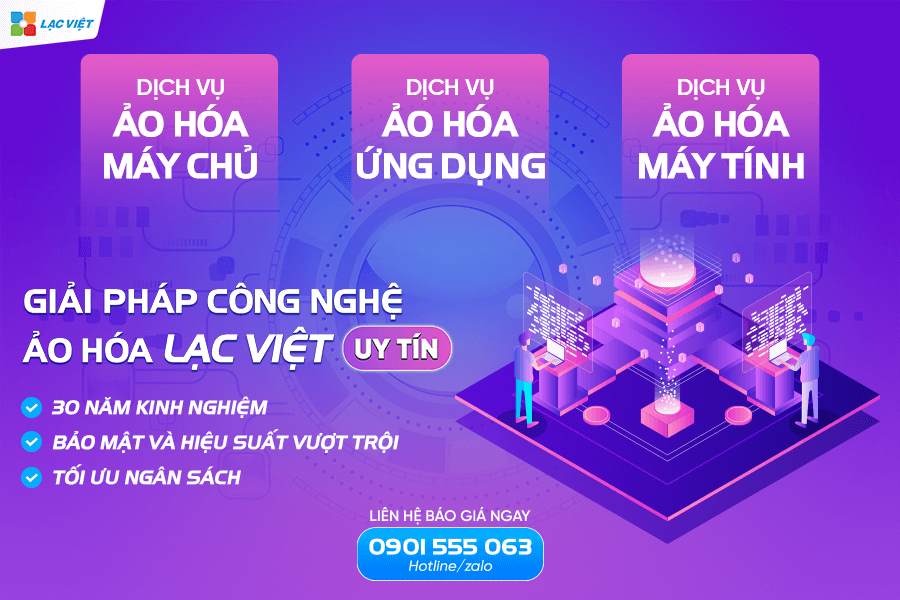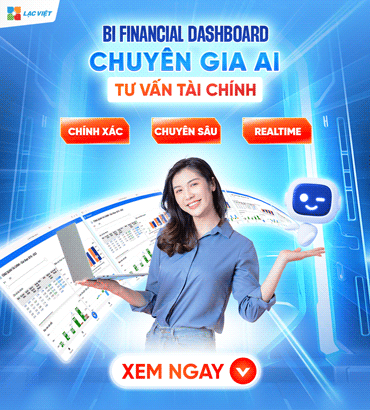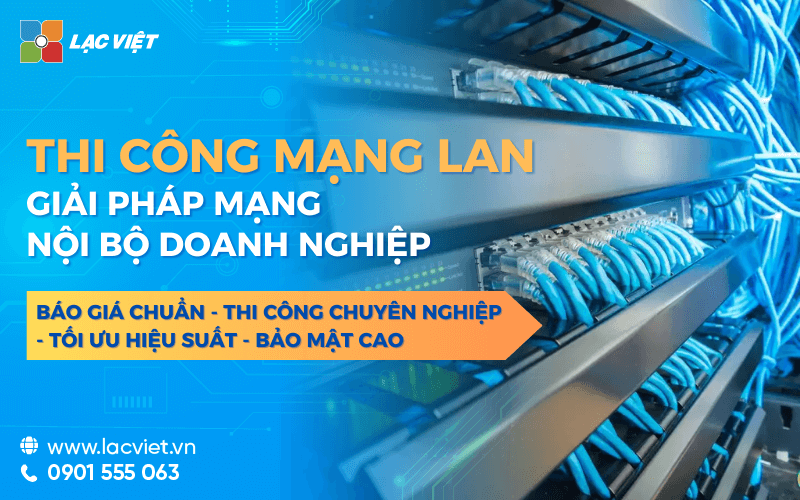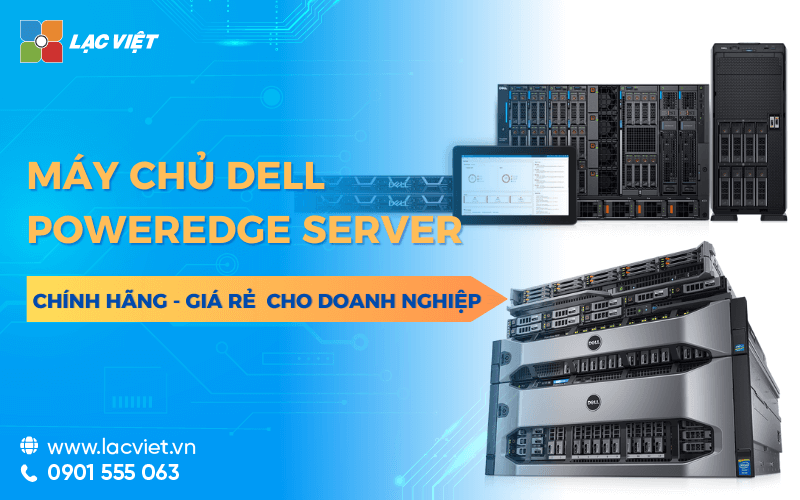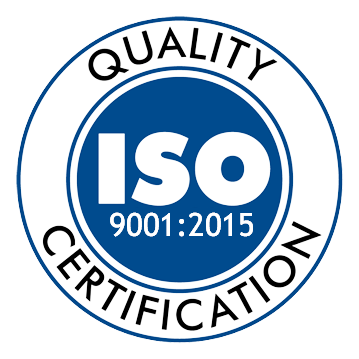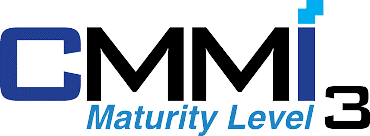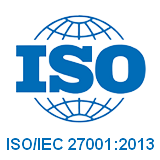In the digital era, businesses are standing in front of the urgent need for improving operational efficiency, cost optimization technology. One of the highlights solutions to meet this demand is Application Virtualization (virtualized application). This technology not only helps the business make maximum use of resources, IT infrastructure, but also support to improve productivity, ensure flexibility in the work environment.
This article Lac Viet Computing will help you to understand about the virtualization application, how it works and why it's become inevitable trend for modern business.
1. Application Virtualization is what?
Application Virtualization the technology allows the application works without installed directly on the terminal. Instead, the application is separate from the operating system running on a virtualization layer. Users can access the application via the intranet or the Internet, minimize the dependency on the hardware configuration of the device.
For example: Instead of installed Microsoft Office on each computer, businesses can virtualize this application to employee access used by the server.
Difference between Application Virtualization and the virtualization technology other:
- Server Virtualization: Virtualization entire server, create multiple independent virtual machines on a hardware.
- Desktop Virtualization: Ảo hóa máy tính cá nhân, cho phép truy cập từ bất kỳ thiết bị nào.
- Application Virtualization: Just focus on applications, not dependent on the hardware platform or operating system of the terminal.
2. The common form of Application Virtualization
Application Virtualization there are two main forms, each form brings different benefits depending on your needs, infrastructure of the enterprise:
2.1. Remote Application Delivery
This is the most common form of Application Virtualization, where the application is installed to run directly on a central server, but the interface, the operation of the application is displayed on the user device via the network.
How it works:
- The application works perfectly on the server, from data processing to storage.
- Devices, users only need a client software (client software) or web browser to connect to the server.
- The manipulation of the user is transmitted on the server, handle at that, and the result of the user device in real time.
Advantages:
- Optimal performance: Because all the processing is done on the central server, the user device does not need configuration help reduce the cost of hardware investment.
- High security: No data stored on personal devices, reducing the risk of leakage or loss of data when the device is stolen.
- Easy to manage: Every update or change app just made on the server, no need to interfere with each individual device.
Practical application:
- Business finance use Remote Application Delivery to provide trading app for employees at branches that are not installed directly on the computer of each person.
- Education sector development learning software for students remotely, allowing them to access anytime, anywhere.
2.2. Streaming Applications
This form focuses on providing application according to your needs, downloads only the components needed for application operation. The rest is stored and processed on servers.
How it works:
- When users open an app, only the core components (core components) necessary to launch the application is transmitted immediately from the server.
- The rest, as the module or additional functionality, only downloaded when the user requests to use.
- User data remains stored centralized on the server to ensure the security and consistency.
Advantages:
- Save bandwidth: No need to download the entire application on the user device right from the start, helping to minimize bandwidth usage increase access speed.
- Reduce deployment time: The app can be used almost immediately, without waiting to complete download at the whole.
- Compatible flexible: User can use apps on a variety of devices, operating systems without complex configuration.
Practical application:
- The business graphic design or technical use Streaming Applications to provide CAD/CAM software, only when necessary, saving resources and operating costs.
- In the retail industry, the inventory management application or point of sale (POS) is provided in this form to optimize work efficiency.
Compare Remote Application Delivery and Streaming Applications
| Criteria | Remote Application Delivery | Streaming Applications |
| How it works | The application runs entirely on the server, display the remote interface. | Downloads only the components required, the rest on the server. |
| Hardware requirements | Depends mainly on the server, the user device requirements low. | Server and the user device needs the right balance of resources. |
| High speed access | Requires stable network connection to feedback quickly. | Start-up speed faster for downloading only necessary ingredients. |
| In accordance with industry | Finance, education, services remotely. | Innovative industry, retail, industrial manufacturing. |
These two forms, though there are differences in how you deploy, which bring flexibility, high efficiency for businesses to help them optimize their operational processes enhance competitiveness in the market.
3. Benefits of Application Virtualization for business
3.1 save the investment cost and operating
- Reduce hardware costs: Application Virtualization allows to handle complex tasks on a central server, to help businesses reduce investment demand on the individual device configuration. For example, the heavy application of graphics or data analysis can now run smoother on a server, while employees just terminal lighter to visit.
- Cut maintenance costs: All updates, patches or software maintenance is performed centrally on a server. This helps reduce the operating costs for the IT team at the same time limit the duration of interruption of work due to maintenance or bug fixes each individual machines.
- Prolonged equipment life cycle: Thanks to reduced work load for the individual, enterprises can extend the lifetime use of existing hardware, from which optimize the cost of long-term investment.
3.2 enhance flexibility and ability to work remotely
- The ability to access anytime, anywhere: Employees are no longer restricted by location or device-specific. Just have an internet connection, they can access the application from the office, home or when traveling. This is especially useful in the context of ongoing business model work remotely or hybrid.
- Compatible platform: An application is virtualization can run on the different operating systems (Windows, macOS, Linux) without the need for complex configuration. This helps business flexible deployment on a variety of devices that employees are using.
- Enhanced performance working group: With the ability to access the application focus, employees easily share data, resources and work collaboratively in real time without the need to download or install the application locally.
3.3 advanced security
- Centralized data protection, better: All information is store manager at central server instead of scattered on the individual device. In case the device is lost or infected with malware, important data remains safe on the main system.
- Management, flexible access: Administrators can control the use of each person or each group, ensuring that only authorized employees are permitted to access the app or sensitive data.
- The ability to monitor restore: Thanks to focus, the business can monitor activity using the app, early detection of security risk. In addition, in case an incident occurs, the data recovery also becomes easier and more quickly.
3.4. Simplify application management
- Centralized management: Administrators only need to manipulate on a platform to install, update or uninstall applications. This not only saves time but also reduces errors compared to the work done on each machine individually.
- Automate the task IT: Lot of manual work, such as software deployment or test configuration is automated through the system virtualization. Thanks to that, the IT team can focus on the task to be more strategic, such as optimizing system or develop new solutions.
- Meet the fast changing needs: When required to deploy new applications or change the configuration, businesses can implement immediately without disrupting the work of employees.
3.5. Improve work performance
- Reduce the duration of interruption :Thanks to the operating environment is stable on the server, the app virtualization less trouble than running on multiple individual machines. This help reduce the waiting time of staff when handling work.
- Higher performance: Application is running on the server configuration to be optimized to achieve best performance. Employees can perform the task requires a lot of resources with no delay or lag-lag.
- Meet loads big work: The server system has the ability to handle multiple simultaneous requests from the employees that do not affect overall performance. This is in accordance with the business there are number of personnel.
3.6. Support the expansion of enterprise scale
- Scalable, flexible: When business grows, adding new users or deploy additional applications can be made quickly without a large investment in infrastructure, new.
- Easy integration: Allow seamless integration with the technology solutions and other systems such as ERP, CRM or software project management.
- Meet demand growth: With the support of virtualization technology, businesses can quickly adapt to the change of market that does not meet obstacles on technology.
4. Application of Application Virtualization in the enterprise
Application of Application Virtualization not only help business cost optimization and operation, but also suitable for many different industries. Below is the use case specific:
4.1 the financial sector – banking
- Security of customer data: In the financial sector – banking, security, customer data is a top priority. The app online transaction such as account management, payment processing, or financial reports that are run on a centralized server, ensure data is not stored locally on the individual devices help minimize the risk of information leakage when the device is lost or infected with malicious code.
- Support remote work safety: Banks often require employees access to internal system to handle sensitive material. Application Virtualization allows employees use this app to remotely without the need to download data on individual machines. For example, employees can perform the transaction or test report from any where, with all operations are handled directly on the bank server.
- Easy to deploy the new application: When necessary, introduction of new banking services, for example, application, asset management, or investment report, virtualization technology helps rapid deployment without the need to install on each device your employees or customers.
4.2 education
- Distributed learning software easy: Schools and educational institutions often have difficulty in implementing learning software on a large scale, especially with many different devices. Application Virtualization allows provider of software, such as software simulation, application language, or programming tools to thousands of students without the need to install manually on each machine.
- Support distance learning: In the context of distance learning become the trend system application virtualization ensure students can access the learning app from any device, whether computer, tablet, laptop or phone. Not only increase convenience, but also reduce the burden on the IT team of the school in the management software.
- Resource management and efficiency: The market can allocate resources depending on the needs of each class. For example, the heavy duty software such as AutoCAD or MATLAB only need to grant access to student related, which saves system resources.
4.3 Business manufacturing and retail
- Application management, ERP, CRM focus: The manufacturing enterprises often use ERP system (Enterprise Resource Planning) to manage the supply chain, warehousing, financial. Application Virtualization enables enterprises to implement ERP or CRM (Customer Relationship Management) on a centralized platform helps ensure data consistency easy access from the home computer or branch office.
- Increase the effective integration between the departments: When the application is virtualized, the departments such as production, sales, accounting can access the same application which is not limited by the hardware or the operating system. Improve information flow help businesses react quickly to changes in production or customer needs.
- Extended support quickly: Manufacturing enterprises can expand the scale of production or open more retail outlets without worrying about reinstalling the software on the new device.
5. The popular solution for Application Virtualization
5.1 VMware ThinApp
VMware ThinApp is one of the leading solution in the field of Application Virtualization, enables enterprises to deploy applications without installing directly or change the operating system.
Highlights:
- Standalone operation, no need client software.
- Easy integration into the environment IT is in.
- Support multi-platform, and backwards compatible with the old app.
Practical application: VMware ThinApp is often used in large organizations want to virtualize complex applications without interrupting the current system.
5.2 Microsoft App-V (Application Virtualization)
Microsoft App-V to deliver virtual applications strong focus on improving operational efficiency, reducing cost of software deployment.
Highlights:
- Centralized management through the Microsoft Endpoint Manager.
- Support tightly integrated with the Microsoft ecosystem (Windows Server, Office 365).
- Minimize conflict between the application on the user device.
Practical application: Business suits have used the Microsoft products, which helps to synchronize processes, optimizing costs.
5.3 Citrix Virtual Apps and Desktops
Citrix is a leading solution for organizations that want to provide application virtualization environment and work remotely with high performance.
Highlights:
- Allow access from any device with optimal performance.
- Features advanced security, in accordance with business require high safety data.
- Support multi-platform, from Windows to macOS, Linux, mobile devices.
Practical application: Especially effective for businesses that need to deploy the working environment remote or complex applications on a large scale.
Comparison between platforms
| Criteria | VMware ThinApp | Microsoft App-V | Citrix Virtual Apps and Desktops |
| Cost | Higher cost but comes with performance and integrated powerful. | Optimized for the enterprise using Microsoft ecosystem. | Costs fluctuate depending on the scale of deployment, often higher than other solutions. |
| Performance | Good performance, less influence to system resources. | Stable, specially optimized with Windows environment. | High performance, particularly with the environment working remotely or platform. |
| The ability to support old app | Good, easy to integrate old application without changing the source code. | Good, but limited in the app which belongs to the Microsoft ecosystem. | Good support but requires technical configuration more complex. |
| Scalability | Easy to extend, in accordance with large-scale enterprise. | In accordance with the small and medium enterprises. | Extended support flexible matching multi-national enterprise. |
| Security | Integrated security basic, easy to manage. | Well thanks to deep integrations into the Microsoft platform Security. | Outstanding features with high-level security such as encryption end, real-time monitoring. |
Review overview:
- VMware ThinApp: Suitable for big business need high-performance and management of IT infrastructure complexity.
- Microsoft App-V: In accordance with the business use of the Microsoft solution, help save costs and maximize ecosystem.
- Citrix Virtual Apps and Desktops: The most versatile solution ideal for business, multi-platform, or should deploy remote work.
6. The steps to deploy solution Application Virtualization efficiency
To deploy Application Virtualization effectively, businesses need to focus on many factors from selected partners technology needs assessment, to ensure network infrastructure security. Here are detailed instructions:
Step 1. Select technology partner prestigious
Choosing a partner reliable technology is the key factor to help ensure the success of the project virtualization application.
Criteria for selecting partners:
- Experience: Partners need to have experience in deploying Application Virtualization in the same field with your business, ensure that you understand the particular requirements.
- Technical support: Unit provides services to commit to 24/7 technical support, especially in the early stages when the business get acquainted with the technology.
- Reputation: Selection of reputable vendors such as VMware, Citrix, or Microsoft, the big names in the industry, virtualization technology.
Advantages of cooperation with reputable partners:
- Ensure the system is properly implemented standard minimize risk.
- Supports business optimization costs, deployment time.
- Provide the documentation, personnel training IT in-depth.
If you are looking for a virtualization solution matching:
- Please contact us Vietnam today to get advice, quotes, details, plans to deploy efficient, helping to save maximum cost and time.
- Support from the design, deployment, to maintenance of the system with the optimal solution for your business.
SEE DETAILS VIRTUALIZATION SERVICE FROM LAC VIET COMPUTING
CONTACT INFORMATION:
- Lac Viet Computing Corporation
- Hotline: 0901 555 063 | (+84.28) 3842 3333
- Email: info@lacviet.vn – Website: https://lacviet.vn
- Headquarters: 23 Nguyen Thi Huynh, P. 8, Q. Phu Nhuan, Ho Chi Minh city
Step 2. Reviews specific needs
Before deployment, businesses need to clearly assess user needs, thereby bringing out the most suitable plan.
The step needs assessment:
- Specify the application need virtualization: App reviews how is critical (such as ERP, CRM, or other app data analysis) to priority deployment.
- Predict the number of users: Define the number of staff will use the application virtualization and how they will visit.
- Performance analysis requires: Measure the volume of work that the application will handle to ensure the system strong enough.
Benefits:
- To avoid waste of resources for the application is not required.
- Ensure scale deployment in accordance with the budget, the existing capacity.
- Create platform to scale up in the future without any obstacles.
Step 3. Check and optimize network infrastructure
Network infrastructure is the key factor to decide the operational efficiency of Application Virtualization.
The steps need to perform:
- Reviews bandwidth current: Ensure the internal network (LAN), internet connection has enough bandwidth to handle the amount of simultaneous access from multiple users.
- Network optimization: Using technology such as SD-WAN (Software-Defined Wide Area Network) to improve network performance, reduce latency.
- Investment in network equipment: Use the network equipment such as router, switch, access point supports high-speed stable connection.
Benefits:
- To avoid service interruptions when multiple users access at the same time.
- Ensure access speed fast user experience smoother.
- Support heavy-duty applications requiring handling big data as data analysis, or simulation.
Step 4. Enhanced security
Security is a top priority when deploying Application Virtualization, especially when business data is stored centralized processing on the server.
The security solution needed:
- Data encryption: Use encryption technology (Encryption) to protect data during transmission, especially when the employee remote access.
- Access management: Application of the system of two-factor authentication (Two-Factor Authentication – 2FA) and manage access rights in detail according to the role (Role-Based Access Control – RBAC).
- Continuous monitoring: Use monitoring tools real-time to detect, prevent the security threats.
- Restore backup data: Building plan backup data periodically to ensure the ability to recover quickly when incidents occur.
Application Virtualization is big step in the process of modernization of the technology infrastructure of the business. With the ability to optimize cost, enhance security and support environment, flexible working, this technology not only suitable for big businesses but also the considerable selection considerations for the small and medium enterprises. By understanding the concept, how it works, businesses can deploy virtualized applications in an effective way, to create a solid foundation for the switch number in the future.
CONTACT INFORMATION:
- Lac Viet Computing Corporation
- Hotline: 0901 555 063 | (+84.28) 3842 3333
- Email: info@lacviet.vn – Website: https://lacviet.vn
- Headquarters: 23 Nguyen Thi Huynh, P. 8, Q. Phu Nhuan, Ho Chi Minh city

